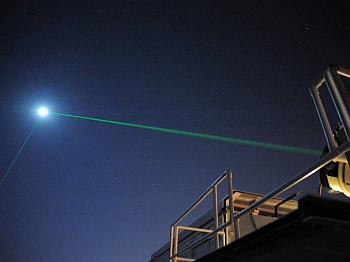
During the Apollo 11 Moon mission in 1969, astronaut Buzz Aldrin placed two experiments on the moon during an extravehicular activity. See Figure 1.

Figure 1 In astronaut Buzz Aldrin’s left hand is a seismic experiment, and in his right is a laser-reflecting panel (Image from NASA)
The reflectors on the Moon’s surface are the last working science experiment from the Apollo program. Each of these reflectors contain cubes created from the corners of glass cubes which function like mirrors reflecting light back in a multi-directional manner.
Why did NASA do this experiment?
This was a fairly straightforward experiment: Just aim a beam of light at the reflector and clock the amount of time it takes for the light to return to Earth. Decades of making this one measurement has led to major discoveries.
One of the biggest discoveries is that the Earth and Moon are slowly drifting apart at the rate which our fingernails grow, or 1.5 inches (3.8 centimeters) per year. This widening gap is the result of gravitational interactions between the two bodies of the Earth and the Moon.
The older, larger reflectors on the lunar surface are sending weak signals, which are only able to return about a tenth of what NASA had expected. Scientists think that this might be due to dust which has collected on the five panels over time. These reflectors are only the size of a paperback novel about 240,000 miles (385,000 kilometers) away from Earth. Figure 2.

Figure 2 A reflector placed on the Moon during the Apollo 14 mission in 1971 (Image from NASA)
Mostly, dust particles are due to micrometeorites frequently impacting the Moon’s surface, sending up dust that then settles back down on the surface of the Moon and on the mirrors as well. Dust will not only block light from the mirrors, but can act as an insulating layer which will cause the reflectors to overheat.
Testing the signal strength of the pristine reflector on NASA's Lunar Reconnaissance Orbiter can help scientists determine what is happening with the reflectors on the Moon’s surface. Thus far, the science team isn't sure if it is dust. But this successful signal is only a beginning to learning what is happening on the Moon's reflectors.
Erwan Mazarico, a planetary scientist at NASA’s Goddard Space Flight Center in Maryland said “Laser-ranging science is a long game.”
There is also a reflector mounted on the Lunar Reconnaissance Orbiter (LRO), a spacecraft that has been studying the Moon from its orbit since 2009. Engineers placed the reflector on the LRO because it was a pristine target to help test the reflecting power of those panels left on the Moon’s surface about 50 years ago. This reflector is smaller than the reflectors on the Moon and since it is on the LRO moving much faster than the Moon, the chance of hitting it and receiving a signal back is even smaller.
Scientists at NASA's Goddard center were finally successful once they collaborated with French researchers on the Géoazur team at the Université Côte d'Azur. NASA used the laser station in France to send a laser of infrared light, which passed through Earth's atmosphere more efficiently.
This effort received 200 photons back out of the tens of thousands sent to the LRO over a few days in 2018 and 2019.
The success of this experiment may lead to future reflectors that will be placed on the Moon, along with development of facilities with infrared lasers and more accurate measurements of the Earth and the Moon that may reveal mysteries of the Moon's past.
References
1 Mazarico, E., Sun, X., Torre, J. et al. First two-way laser ranging to a lunar orbiter: infrared observations from the Grasse station to LRO’s retro-reflector array. Earth Planets Space 72, 113 (2020). https://doi.org/10.1186/s40623-020-01243-w
 Steve Taranovich
Steve Taranovich
Discussions
Become a Hackaday.io Member
Create an account to leave a comment. Already have an account? Log In.